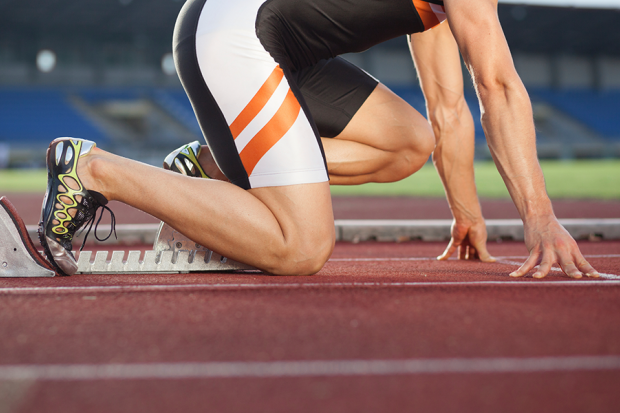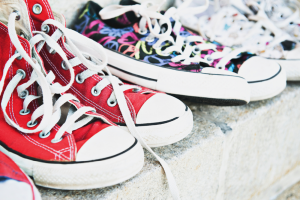Summer Olympics 2016 Why Some Olympic Athletes Are Running From Shoe Logos
Find out why track and field athletes are hiding the brand of their Olympic shoes with tape, spray paint and elastic sleeves.
The common saying is to “run and hide,” but when it comes to their shoes, many Olympic athletes are doing the opposite: hide and run.
An in-depth article in the NY Times reveals that there’s a little bit of “creative subterfuge” going on during this year’s Olympics, with many track and field participants using tape, markers, elastic sleeves and even spray paint to hide logos and branding on their Olympic shoes. But why not let the world know they’re wearing Nike, Asics, or Adidas shoes? After all, flashing a particular shoe logo serves as an advertising billboard for a particular shoe company, and it can provide financial gain for participating athletes. The answers might surprise you.
Olympic Shoes: No Representation Without Compensation
All United States track and field Olympians at this year’s Rio Games are required to wear Nike uniforms that bear the company’s swoosh logo, as Nike is an official team sponsor. However, the athletes are free to wear whatever brand of shoes they’d like. Some have taken a stand against representing a shoe company without being paid for doing so by hiding the shoes’ logos — an act Seattle decathlete Jeremy Taiwo describes as “No representation without compensation.”
Not All Olympic Shoes Deliver
Sometimes an athlete has a contract with a particular shoe company that may not produce shoes made for his or her sporting events. For example, Taiwo will wear eight pairs of shoes in his 10 events, “each with a function as specific as a golf club’s,” NY Times writes. Taiwo’s sponsor is Brooks, but because the company does not make shoes designed for jumping and throwing events, he’ll be wearing shoes from other athletic companies. However, because he’s under contract with Brooks, he must cover the Nike, Asics and Adidas logos.
“In terms of athletic performance, you have to have the right shoes to be able to meet your goals,” Taiwo said just before traveling to Rio de Janeiro. “And ultimately, you have to do well so you can get paid. If you make it, your shoes are largely responsible for that.”
Dissatisfaction With Sponsor Shoes
Though less common, some Olympic athletes are simply let down with the performance of the gear made by their sponsor. A widely reported 2013 incident had Nike withdrawing a contract offer to American record-holding pole vaulter, Brad Walker, after the athlete was photographed with tape strapped around his shoes that covered the Nike swoosh logo. Walker defended his actions on Facebook, writing that he was not trying to sabotage Nike’s name, but was rather using the tape to “hold together a shoe that shouldn’t break down within 6 months.”
Meanwhile, 2011 American javelin champion Mike Hazle claims his Nike shoes were too narrow, causing not only numb feet, but also his toenails to fall off. He disguised shoes from other brands and wore them for years without a problem — until he won the United States title and a photograph revealed a Li-Ning logo on the bottom of his shoes. Needless to say, Nike was none too pleased with Hazle’s shoe choice and exercised an option on his contract to keep him from signing with any other company. “[It’s unfortunate] if someone is paying your bills and you’re supposed to wear what they give you and it doesn’t work,” Hazle said from Afghanistan, where he is serving in the Air National Guard. “But at the end of the day, it’s going to compromise your performance, so you’ve got to take care of yourself.”
How Much Olympic Athletes Are Paid For Wearing Sponsor Shoes
When athletes do decide to sport sponsor shoes, the financial reward is significant. Many successful athletes report earning anywhere from $10,000 to $25,000 annually for wearing sponsor shoes, but highly visible stars like Jamaica sprinting champion Usain Bolt make considerably more. Usain is sponsored by Puma and makes $32.5 million per year, including $30 million in endorsements. And some athletes are strongly against hiding logos because of this. Says US 200-meter sprinter Wallace Spearmon: “If they’re paying money, the least we can do is respect their dollar.”
For more on the Olympic shoe logo debate, check out NY Time’s original article, Olympic Cover-Up: Why You Won’t See Some Shoe Logos.
Notice concerning medical entries:
Articles having medical content shall serve exclusively for the purpose of general information. Such articles are not suitable for any (self-) diagnosis and treatment of individual illnesses and medical indications. In particular, they cannot substitute for the examination, advice, or treatment by a licensed physician or pharmacist. No replies to any individual questions shall be effected through the articles.







